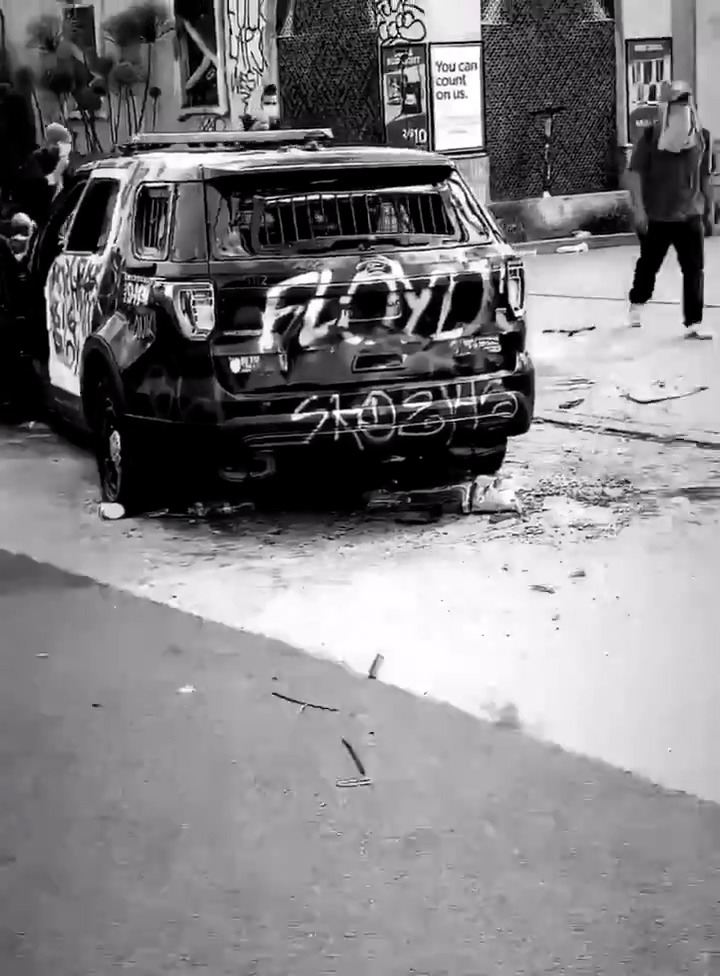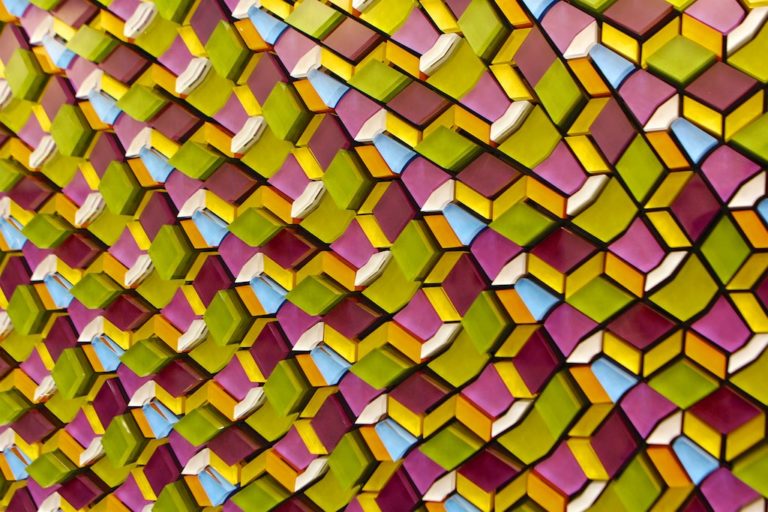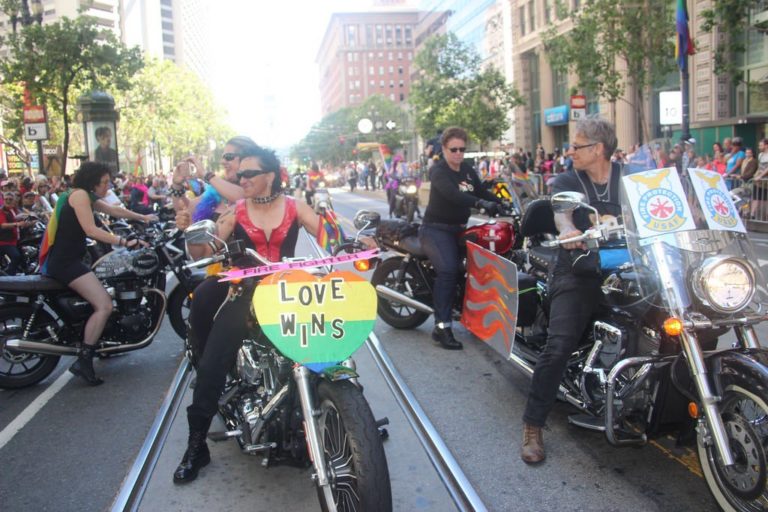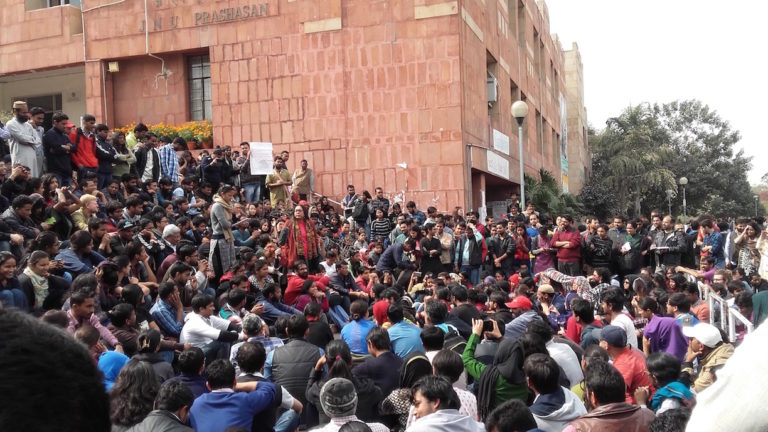In the midst of the COVID-19 pandemic, the murder of George Floyd by Minneapolis police has sparked protests and riots around the world. The policing of the pandemic reveals the racial biases inherent to law enforcement and state-led discipline, laying bare ongoing infrastructural inequalities that render racialized subjects more vulnerable to premature death at the hands of police and public health systems alike. With the video embedded in the article, we guide readers through thirty-nine seconds of rioting in Los Angeles on May 31, 2020, shot on a mobile phone and circulated virally on Twitter. The affected body of the witness indexes both the intensity of the event and the embodied experience of the witness, establishing a relation between the two. The experiential aesthetics of the video exceeds the content and this affectivity circulates with its mediation and movement through networked platforms. Such forms of affective witnessing allow for an attunement to political struggle that occurs through what Hortense Spillers would call the analytic of the flesh. Thinking at the intersection of Black studies, affect theory, and media studies, we argue that the flesh is an affective register crucial to the building of global anti-racist solidarities towards abolition.
Keyword: protest
Review of Premonitions: Selected Essays on the Culture of Revolt by AK Thompson (AK Press)
In this series of essays written over the last decade, AK Thompson offers a critical assessment of the analytical foundation underwriting contemporary social movement politics. Methodologically and conceptually influenced by Walter Benjamin, Thompson looks to visual culture, everyday life, and collective street actions as crystallizations of the logics saturating our culture of revolt. Through generative critique, creative conceptual development, and a consistent orientation toward identifying politically possibility, Premonitions lays the groundwork for social movement scholars and activists alike to develop a conceptual toolkit for moving beyond the mere existence of struggle as an end in itself.
Art as Protest, Cooking as Resistance: Everyday Life in Taipei’s Housing Rights Movement
From 2010 to 2013, during the height of Taiwan’s housing rights movement, Participatory Art became instrumental in defending the right to the city. In this housing rights movement, artists, students, residents, and other professionals united to challenge neoliberal urban development. Two protest art projects in Taipei, Operation Little Barbarossa and Cooking at the Front Line, illustrate the interdisciplinary, trans-social strata collaboration. The artworks responded to encroachment on land and estate by the Taipei City government and real estate developers. The art forms employed included performance art, dance, writing, sculpture, graffiti, graphic design, and photography. Through everyday acts, such as cooking and driving, the two works lent voice and visibility to marginalized residents. The language and imagery of these protest gestures produced a theatricality that was at once jovial, amiable, critical, and contentious. The coexisting confrontational and convivial tones also encapsulate Taipei’s housing rights movement, in which the Taiwan Alliance for Victims of Urban Renewal exercised a central role. This article integrates findings from archival analysis, interviews, participation observation, and site visits. The content considers the relationship among Participatory Art, social activism, urban planning, and neoliberalism. The author also draws connections between the visual and cultural aspects of the featured Participatory Art. The text concludes that Operation Little Barbarossa and Cooking at the Front Line offer a broader and richer interpretation of Participatory Art. They demonstrate diverse adaptations and multiple approaches to facilitating socially-minded, collaborative art. They also confirm Participatory Art’s ability to agitate problematic dynamics in the (re)construction of global cities.
The Politics and Policy of Noise: Motorcycles Making, Masking, and Muddling the Noise of Protest
Noise plays a specific role in the politics of protest. The use of motorcycles to display affiliations, to protest status quo, and to challenge dominant ideologies is powerful, purposeful, and politically messy. In this essay, I trace the use of motorcycles in various modes of protest; I focus on how motorcycles disrupt the social, revealing the indelible charge of sensorial codes of meaning of producing noise—the productive process of drowning out voices, the turning up the volume of dissident perspectives such as how the San Francisco Dykes on Bikes established a sonic audibility in the 1970s to the recent off-duty motorcycle policemen who through using the loudness of their motorcycles protested Death penalty opponents, to the Patriot Guard Riders who mask the bullhorns of the Westboro Baptist Church protests.
#eatthatwall
#eatthatwall is an in-progress performance-installation, presented first at Rhizome DC (a DIY experimental art space in Takoma Park, Washington, DC) on April 23, 2017. The project invited gallery participants to assist in the construction and eating of an edible wall made with approximately 1,200 mini cooked rice bricks set with refried bean mortar. The wall served as an imaginary, fabulist structure to separate a currently un-bordered area between Laredo in Texas and Nuevo Laredo in Tamaulipas, Mexico, or anywhere else this hypothetical border might arbitrarily fit. The performance score following the introduction to the project is a document of the process of making: from initial concepts, to the invitation to build/mimic, to a contemplation of how we digest the events and emotions leading to the wall, and to its eventual end.
Delhi Dispatches Blogs
Starting in February 2016, a protracted struggle has taken place on the Jawaharlal Nehru University (JNU) campus, pitting the students and their faculty supporters against the right-wing government of Prime Minister Narendra Modi and the Administration of the university. The protestors’ issues chime with the desire to leverage justice that drives this issue. This piece presents one senior scholar and one early career scholar blogging about these events.
Urban Interventions / Intervenzione Urbane
Urban Interventions is a series of collages by Alexander Dellantonio that take the urban terrain with its rapid changes as the matrix of inquiry, presenting the artists reflections on the city. The strong colours used by the artist echo the city’s images, places, people and situations and tattered billboard posters and manifestos torn off the buildings the militants fly-posted them on are reassembled to show the city and its inhabitants in movement. Dellantonio appropriates parts of the city and seeks to return them to the spectator. In so doing, these works not only engage the urban terrain as a space of politics, they also raise questions about mediation in the context of the current crisis of political representation that is being expressed by movements across the world, whether for example in Tahrir or Syntagma Square, at Occupy Wall Street or during the public sector strikes in the UK.





